


Later in the saga ( G.s. ch18), games were held at Seftjörn in the winter. (In Gísli’s time, the pond was probably larger, since the weeds filling in the pond would have been harvested regularly.) However, the game was played in summer, when it is unlikely the pond was frozen. ch15), the small pond next to the fjord shown to the right. The people of Dýrafjörður played knattleikr at Seftjörn (G.s. (That location might be more accurately described as the estuary where the river meets the fjord.) Gull-Þóris saga (chapter 2) specifically states the game was played on the ice at Berufjörður ( á Berufjarðarísi), and Þórðar saga hreðu (ch.3) says that games were played on the ice at Miðfjörður ( á Miðfjarðarísi) between the farms of Reykir and Óss because the fjord froze easily there. Ice certainly figures prominently in the stories ( G.s. ch18, Gr.s. ch15). (The pond where Grettir played is shown to the left as it appears today.) Some modern scholars have suggested that the game was played on the surface of a frozen pond. The playing field was usually near a pond. Loose balls bounced a long way over the ice ( Gr.s. ch15). And if thrown with enough force, it could knock over another player ( G.s. ch15). The ball was hard enough that when thrown in anger at another player, it could cause a bleeding injury ( Gr.s. ch15). Perhaps the bat had some element or elements that allowed it to catch or hold or carry the ball. ch15), the word used is knattgildra, which has the sense of “ball catch” or “ball trap”. The word used in the stories is tré, meaning tree, but used for many wooden objects. The bat was such that it could broken in anger, and that it could be mended on the spot ( G.s. ch18). ) chapters 15 and 18 Egils saga ( E.s.) chapter 40, and Eyrbyggja saga ( Ey.s.) chapter 43. The most complete descriptions of the game in the sagas are: Grettis saga ( Gr.s.) chapter 15 Gísla saga (G.s. We surprised ourselves with how enjoyable the game turned out to be, and we are pleased to present our conjectures for the benefit of other Viking age re-enactors who might want to give it a try. We decided to start with the existing sources, the Sagas of Icelanders, and to try to recreate something that matched the descriptions in the sagas as best we could. But nothing suggests these games derive from knattleikr. Manuscripts from well after the Viking age describe rules for ball games and illustrate the play (left). Some authors have compared the game to various modern games, including hockey, rugby, lacrosse, and cricket, all of which seem very different from one another. Since no hard information survives about the game, any attempt to recreate it is pure conjecture.

In the stories, usually all that’s mentioned is the fact that people played the game, that players had disputes, and frequently, that blood was spilled. No examples of the playing equipment are known to survive. While the game is mentioned in the stories, (such as the Icelandic family sagas), the sources are silent about the details of the game. During several of our recent feasts, we have attempted to recreate the Viking era ball game called knattleikr.


 0 kommentar(er)
0 kommentar(er)
